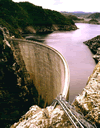Windmills
 Windmills have been used for a very long time to harness the energy
of wind. A windmill has vanes that turn in the wind and, by connecting
them to a central axle, the force of the wind can be transmitted to a
variety of devices. Early windmills were used to turn a grinding wheel
over a stationary stone to grind flour. The Southern Cross windmill can
be used to lift water from an underground supply, or to turn a generator
to transform the rotational kinetic energy to electrical energy. Aerodynamically
designed windmills are used now in wind farms to generate electricity
for the mains supply.
Windmills have been used for a very long time to harness the energy
of wind. A windmill has vanes that turn in the wind and, by connecting
them to a central axle, the force of the wind can be transmitted to a
variety of devices. Early windmills were used to turn a grinding wheel
over a stationary stone to grind flour. The Southern Cross windmill can
be used to lift water from an underground supply, or to turn a generator
to transform the rotational kinetic energy to electrical energy. Aerodynamically
designed windmills are used now in wind farms to generate electricity
for the mains supply.

Waterwheels
Wherever there is flowing water there is energy. Mills were often
built over a waterway to capture the movement energy of flowing water,
and convert it to rotational kinetic energy driving stone wheels to grind
flour. The energy from waterwheels was also used to drive other machinery,
or to move objects.

 Hydroelectricity
Hydroelectricity
The gravitational potential energy of water stored in high dams
is converted into kinetic energy as the water is funneled through pipes
to drive turbines and electrical generators in hydroelectric power stations
to produce electrical potential energy.
 Fossil
fuels
Fossil
fuels
Coal, oil or gas are burned in thermal power stations to heat and boil
water. The water turns to steam under great pressure and it is this steam
that drives turbines that generate electricity for the mains supply. Any
of the fossil fuels can be used to convert water to steam, the appropriate
one being dependent on supply. Here the chemical potential energy stored
in the fossil fuel is released, transferred to the water as thermal energy
turning the water into steam. The steam then transfers its energy to kinetic
energy in the turbine and finally electrical potential energy in the generator.
Nuclear energy
Another way of heating water to convert it to steam is by nuclear power.
Here the nuclear potential energy stored in radioactive elements is converted
to thermal energy and from then on the transfer is as for fossil fuels
- water to steam to turbine to electricity.
 Solar energy
Solar energyEnergy from the Sun can be used directly by exposing black tubes containing water to the Sun's energetic rays. The water is heated as the Sun's energy is transferred to the water. Another way of using the Sun's energy is through photovoltaic cells, where the energy is converted directly to electrical potential energy. This is a valuable source of electrical energy in remote districts, or on vehicles such as solar powered cars.
| Copyright owned by the State of Victoria (Department of Education and Early Childhood Development). Used with Permission. |